Eduard 1/48 Fw-190A-6 – Erich Rudorffer
The Eduard Fw-190A-5 kit modified to Fw-190A-6.
The Fw-190A series was so right in design that - once the problem of providing adequate cooling for the BMW 801 radial engine was solved - the airframe went through little modification other than minor changes associated with changes in armament.
The one major change between the early subtypes A-1/A-4 aircraft and the later series beginning with the A-5 involved a change in the engine mount for center-of-gravity problems associated with use of various armament fittings. This lengthened the forward fuselage 5.9 inches, just ahead of the wing leading edge.
The Fw-190A-5 and A-6 are the main production versions of the "mid-range" Wurger; the Fw-190A-3 and A-4 being the main versions of the early-production range, and the A-8 being the main version of the late production range.
The Fw-190A-6 was the last version of the “mid-range” Fw-190A series. As with the A-2, A-3, A-4 and A-5 sub-types, it had two 7.62mm machine guns mounted in the fuselage, for primary use as “sighting weapons.” Unlike the earlier versions, it dropped the outer-wing 20mm MG-FF drum-fed cannon - which had presented problems from the outset with its slower rate of fire and differing range and trajectory from the excellent 20mm MG 151 mounted in the wing roots - and provided an all-MG 151 armament since the main use of the Fw-190A-6 - and the reason for its existence with its heavy armament - was on the Western Front, where the USAAF's 8th Air Force was gathering strength and reaching out across Western Europe and into Germany in the spring and summer of 1943 when the A-6 made its appearance. The A-6 was also the first version to use the new lighter-weight wing that would become standard for all Fw-190s that followed. Due to its comparatively light weight, the Fw-190A-6 was the “last of the dog fighters,” and would be used on the Eastern Front in the air superiority role till the end of the war. Over 1,000 Fw-190A-6s were delivered to the Eastern Front during the winter of 1943-44.
Erich Rudorffer:
It is surprising that in this era when the great Luftwaffe aces of the Second World War are well-known to modelers, that one of the greatest aces is one who can certainly land on any list of the lesser-known.
Major Erich Rudorffer was the seventh-ranked Luftwaffe ace, with 222 victories, a score that opened in the Battle of Britain while he was flying the Bf-109E with JG 2 Richtofen and ended in April 1945 in an Me-262 as the Gruppenkommandeur of I/JG 7, the first jet fighter Gruppe. The fact he did not serve in the postwar Bundesluftwaffe, but rather opted to return to school and become a very successful corporate attorney might have something to do with his relative lack of renown today; that he was described as “reserved and retiring personally” may also be a reason (I had the privilege of meeting Gunter Rall, Walter Krupinski and Adolf Galland in 1984 - no one would call any of those men “reserved” or “retiring” even at that point of their lives).
Of his 222 victories, 74 were scored while flying in the west and in Tunisia, where he scored 27 victories during three months during the winter of 1942 and spring of 1943 as a member of II/JG 2. Rudorffer was definitely a Focke-Wulf ace, inasmuch as 62 of his western victories were scored in the Wurger, and all his 136 Eastern Front victories were achieved while flying Kurt Tank's fighter. His score of 12 in the Me-262 makes him the third-ranked German jet ace of the war, all of which were scored in a five week period between early March and mid-April of 1945, during which time his primary focus as commanding officer was maintaining supplies and operational aircraft.
The pilots he flew with considered that Rudorffer only had two peers in the Jagdwaffe when it came to gunnery skill: Hans-Joachim Marseille and Erich Hartmann. Rudorffer's specialty was multiple kills utilizing deflection shooting and an economy of ammunition.
In a 17-minute engagement on November 6, 1943, Rudorffer shot down 13 Soviet fighters, one after the other. In North Africa on February 9, 1943, he shot down eight RAF fighters in one mission, following that on February 15 with seven more RAF victories in two missions.
Following the withdrawal of German units from North Africa, Rudorffer was transferred to JG 54 on the Eastern Front and promoted to Gruppenkommandeur of II/JG 54. Entering combat that June, he scored eight in two missions on August 24, and seven in one mission on October 11. After his top score of 13 that November, he claimed eleven Russian fighters in two missions on October 28, 1944. No other fighter pilot in any air force equaled this record. Rudorffer was himself shot down sixteen times and had to bale out in nine of those.
By May 1944, I and II Gruppen of the Grunherz Geschwader were the only dedicated air superiority units on the eastern front still equipped with the Fw-190. Though the Fw-190A-8 was available, Rudorffer and his pilots still preferred the Fw-190A-6, which had the same cannon armament as the A-8, but did not carry the fuselage-mounted 13mm heavy machine guns, which allowed it to maintain its edge in maneuverability over the Soviet opposition in air combat.
The Soviet summer offensive, launched three days after the invasion of Normandy, forced JG 54 to withdraw from Russia into Latvia, moving south from Leningrad toward Germany. At the same time, Finnish forces to the north of Leningrad came under heavy attack. Up to this point, the Finns - though allied with the Germans - had largely fought their own war, being primarily interested in recovering the territory taken from them in the Winter War of 1939-40. Now hard-pressed, the Finns asked the Germans for aerial assistance in stabilizing the Karelian Isthmus front.
II/JG 54, with 34 operational fighters, flew to Immola where it became the air superiority section of Gefechtsverband Kuhlmey, which included 20 Fw-190F Schlactjaeger and Ju-87D Stukas from II/SG 2. The unit operated from Immola for a month, during which the Wurgers of II/JG 54 scored 66 victories, including ten by Rudorffer.
With the Karelian Front momentarily stabilized - though it would collapse again in August, forcing the Finns to sue for peace with the Allies - II/JG 54 returned to Latvia. By the end of August, the Grunherzen had retreated into the Courland peninsula, where the unit would fight on until the end of the war in May, 1945, never having more than fifty operational Fw-190s during this time. Their assignment of providing air cover to the hard-pressed German and Baltic forces meant they fought Russian air units comprising a total 3,600 aircraft during the six Russian offensives against Courland. During the first and second offensives in November and December, II/JG 54 shot down 236 enemy aircraft at a loss of 18 for themselves.
Rudorffer left II/JG 54 in February, 1945, his place being taken by Hauptmann Herbert "Mungo" Fineisen, and took command of I/JG 7, the only Gruppe of the Geschwader to attain full operational capability.
Eduard's Fw-190A-5 was released this Spring, and quickly demonstrated that the company's new series of “short nose” 190s were the best kits of the Wurger in 1/48 scale.
Many have noted that the kit has numerous parts that are not needed for the Fw-190A-5. This includes a different propeller, different gun cover, different elevators and horizontal stabilizer, different rudder, different main gear legs and different main gear covers, as well as a substitute part for the area of the main gear wells to cater to the lack of inboard gear covers, the outboard MG 151 cannon breech covers, and the centerline pylon and drop tanks that were not used by the Fw-19A-5. Using these parts, it is not difficult to co “mix and match” to create any Fw-190A from the A-5 through the A-8. All it takes is an extensive stash of aftermarket decals.
Fit is very tight with these kits, and one must be certain to clean off all sprue nubs. With care in assembly, there is no need for filler on any seams. The only difficulty I encountered was the very tight fit of the door panel of the inboard cannons to the fuselage when assembling the wing and fuselage sub-assemblies. I found that lightly scraping the mating surfaces for this area leads to a trouble-free fit, while not doing so can lead to some “industrial strength pushing and shoving.” You are advised to take the time to do that light scrape-down.
I started with the cockpit, painting all the parts and then assembling them. The photo-etch instrument panels are a real improvement here, since they and the seat are about the only things really visible in that tight cockpit. After gluing the cockpit in position and the engine plug, I finished the fuselage and set it aside after attaching the gun cover and the engine and cowling sub-assembly.
Assembly of the wing is equally stress-free, other than I suggest you cut off the forward barrels of the inner cannons, since they stick out and will get bent or broken off by handling during assembly and painting. The barrels can then be easily attached at the end of the project. I also drilled out the holes in the outer upper wing part for the cannon breech covers.
Ailerons, elevators and rudder are separate parts. I attached the ailerons and rudder in the neutral position and “drooped” the elevators.
Erich Rudorffer's Fw-190A-6 looks different from others, due to the dark overpainting of RLM 74 on the rear fuselage sides, and that the lower cowling panels were painted RTLM 71. I first painted the yellow areas and masked them off, then freehanded the camouflage with my Tamiya mixtures of RLM 74, 75 and 76. I then applied a coat of clear gloss when all was dry.
I used the individual Gruppenkommandeur's chevron and II Grupp bar from the SuperScale 48-530 sheet, then used the kit decals for the national markings and the stenciling.
The landing gear assembly is fool proof (unless one is foolish enough to deliberately not do things right). Misalignment of the main gear is the main point of failure for most Fw-190 models, but with this kit, if the gear is assembled correctly, it is impossible for it to fit otherwise than with the correct forward and inner cant.
I unmasked the canopy and posed it in the open position.
I love the new Eduard Fw-190s and look forward to the future releases of the other sub-types. This kit is appropriate for everyone from a beginner to a master modeler. Follow the instructions and take your time and a beautiful model is pretty much guaranteed. Highly recommended.
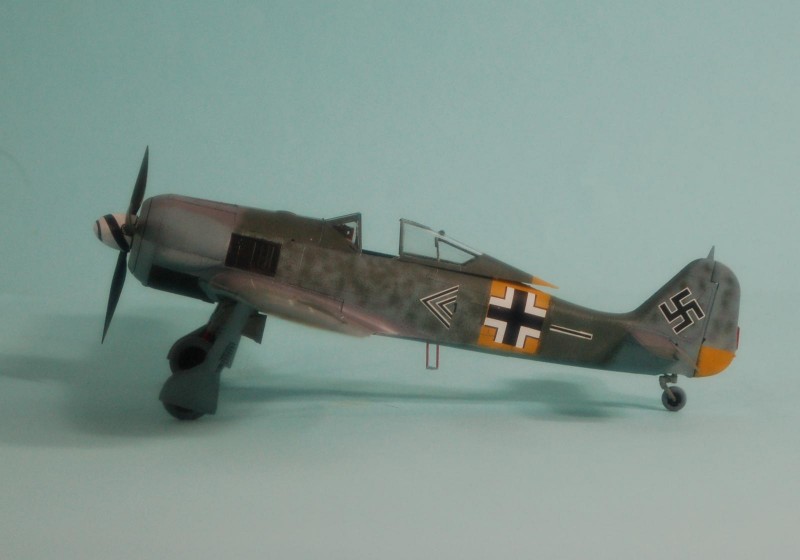

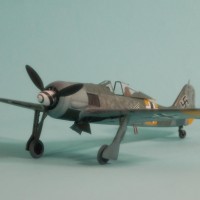
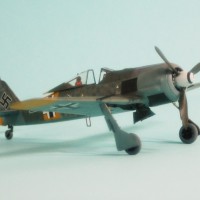
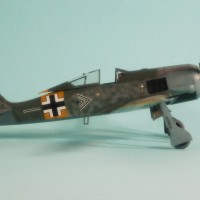
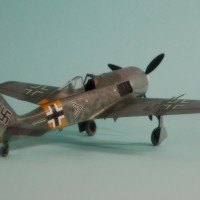
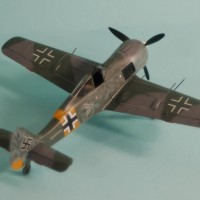
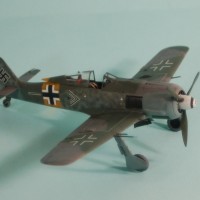


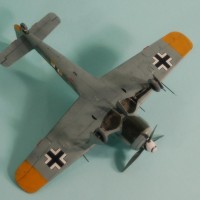

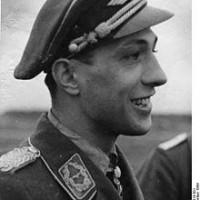
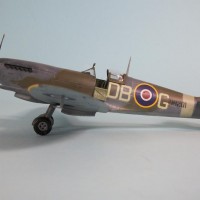
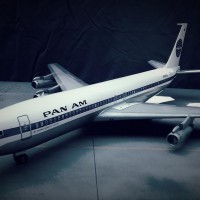
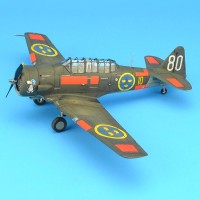
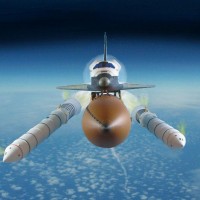
Nice work, TC...as usual.
Nice 190...sharp!
Solid build Tom. nice to see you made the very first new mould A-6 by Eduard 😉 This new version of the 190 is a great kit indeed...easy to build and accurate it takes competition out of the 1/48 game by far.
It's actually an A-5, an easy conversion. Parts are in the kit to do anything from the A-5 to the A-8. The Eduard Spitfires, 109s and now these 190s are the best out there in my book.
Yep, but to do the A-7/8 some panel scribing is needed, otherwise main parts are in the sprue already like you said, especially the version you present us here... hence the “very first A-6”, you are a pioneer 🙂 BTW, just saw the add for their new 109 G-10 to be released next month
Great job on the paint work. I just can't master camo with the spray gun. Just looked at your other models too, great work.
Hey, it probably took me 20years to learn this. It's mostly a case of keeping the pressure around 15psi - you go higher, you get splatter. That and thinning the paint at least 40-45% with thinner. Then tighten the nozzle.
Great info and build as always
Another nice build, Tom!
Having said on one of your recent posts that 'yellow 10' is my favourite individual aircraft I much prefer the radial engined versions. Your insight into this kit is invaluable - thank you!
I like the radial engine Wurgers too. Yellow 10 is favorite individual aircraft for the scheme.